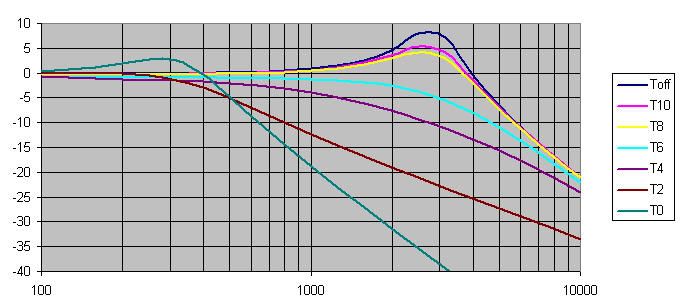Hello! I learned on another (guitar) forum that when you turn the tone knob down, the resonant peak doesn't actually become a smaller value until the tone control is at or close to zero. While the knob is at a higher setting, between five and ten, the resonant peak is still about the same as if the knob were at ten, but the peak amplitude, or Q factor, just becomes lower. Here's a graph someone provided:

As you can see, the movement of the peak isn't a straight line from high peak to low peak, but is instead a "swoosh" where the amplitude drops as the tone control is rolled close to zero, but once it hit's at zero, the amplitude makes a sudden come back, but at a lower resonant peak.
I understand why the capacitor by itself decreases the peak resonance, as it effects the LCR equation to arrive at that end result, but what I don't understand is why the tone knob's dial's relationship to the resonant peak and amplitude isn't more linear. What causes the Q / peak amplitude to drop in the beginning (dial between 5 and 10), and then suddenly pick back up with the lower resonant peak towards the end (dial at/near zero)?

As you can see, the movement of the peak isn't a straight line from high peak to low peak, but is instead a "swoosh" where the amplitude drops as the tone control is rolled close to zero, but once it hit's at zero, the amplitude makes a sudden come back, but at a lower resonant peak.
I understand why the capacitor by itself decreases the peak resonance, as it effects the LCR equation to arrive at that end result, but what I don't understand is why the tone knob's dial's relationship to the resonant peak and amplitude isn't more linear. What causes the Q / peak amplitude to drop in the beginning (dial between 5 and 10), and then suddenly pick back up with the lower resonant peak towards the end (dial at/near zero)?
 ) reading British music magazines, way before Guitar Player if you can imagine that, where I absorbed and reprocessed every tiny bit of data to pull useful info.
) reading British music magazines, way before Guitar Player if you can imagine that, where I absorbed and reprocessed every tiny bit of data to pull useful info.
Comment